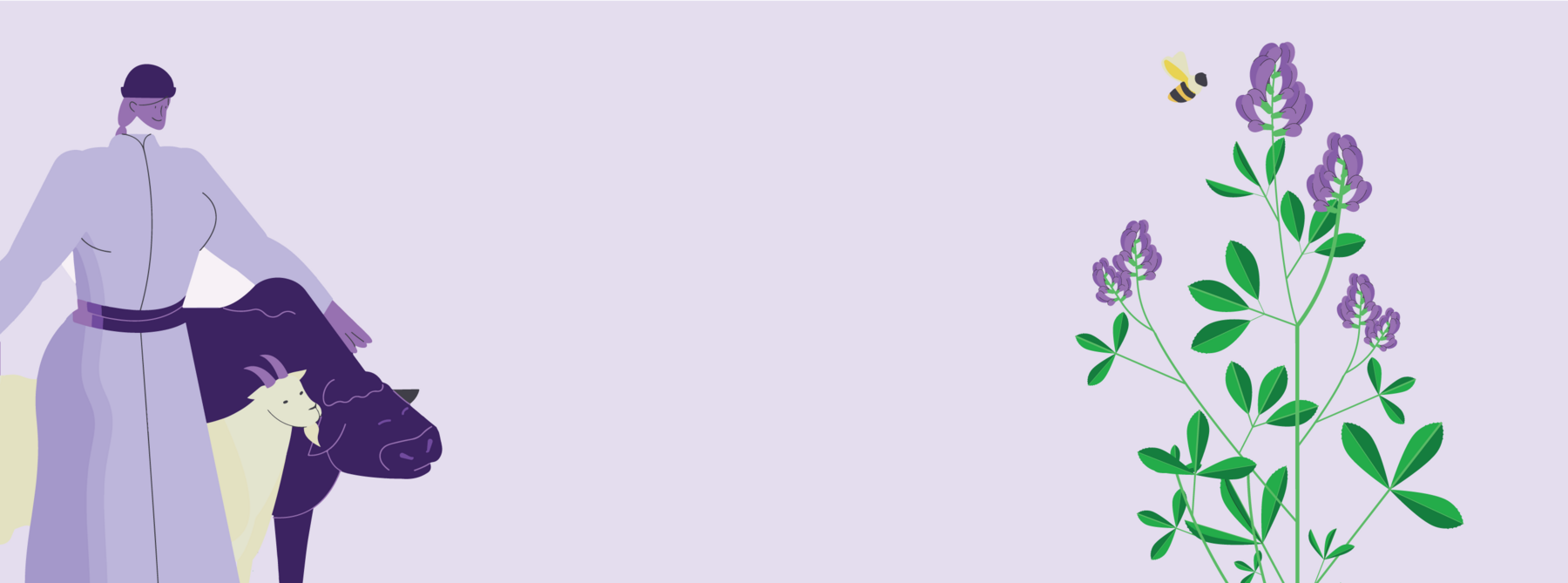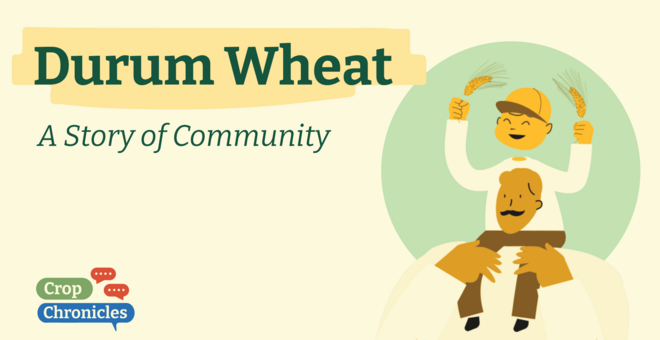CROP CHRONICLES: 15 August 2024
When the soldiers of Athens routed Darius’ Persian army at Marathon in 490 BCE, Greece gained more than a notable victory. The invaders left behind green expanses of the fodder they had planted to feed their horses, camels and other livestock. That was me, and my scientific name – Medicago sativa – reflects both that I came from Media – the region of Iran that was the nucleus of the Persian empire – and that people cultivated me deliberately.
Today, most people call me alfalfa, although a few still cling to my more European moniker, lucerne. I am without a doubt the world’s most important fodder plant, because I can produce large amounts of highly nutritious feed year after year. I’ve ended up around the world, in pasture mixtures and in fields of my own, which are harvested to give hay that is either used as is, or fermented into silage, mostly for dairy cattle and horses. Some is processed into pellets and other forms of concentrated feed that is fed to chickens, because the high levels of carotenoids I contain find their way into egg yolks and skin, turning them a customer-pleasing shade of golden yellow. And, of course, there is the human market: alfalfa sprouts now eat up around 7% of the seed market in the United States and add flavor and crunch to sandwiches, salads and soups.
All this productivity stems from a few key character traits. First, I am perennial, with a crown that is capable of throwing out new shoots every time the existing shoots are mown or munched. Some alfalfa fields have produced a yield for 70 years or more.
Then there’s my extensive root system, which can reach depths of 3 meters in search of water and nutrients, and which has been recorded penetrating down to 15 meters.
Finally, there are my close associates, the Rhizobium bacteria that make themselves at home in nodules on my roots. We have a nice symbiotic relationship: I supply them with some of the nutrients they need, and they, in turn, transform nitrogen in the air into a form I can use, leaving a lot of it to enrich the soil for other plants.
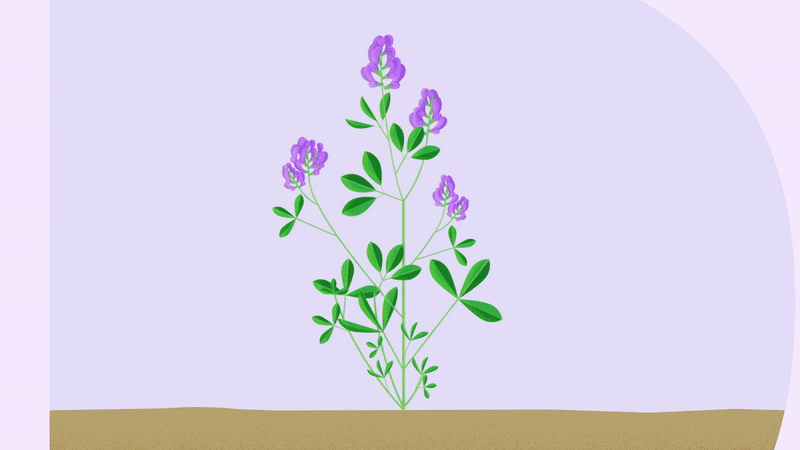
These qualities have seen me spread with people around the world, from Chile and Argentina to Canada and southern Sweden, and from sea level up to 2,400 meters in altitude.
Today, climate change is throwing challenges at me that I’m just not equipped to deal with. That is because in my long history of domestication and cultivation, some of the genes that allowed my wild ancestors to survive the freezing winters of Central Asia – my birthplace – were not useful in more temperate climates, and I eventually lost them. The same goes for drought tolerance. I am not as good as some of my wild relatives at making do with little water.
However, plant breeders are making progress in increasing my genetic diversity and giving me the tools to cope with extremes of cold and drought. My wild relatives from Inner Mongolia, for example, survive winters where the temperature plunges to –30°C (–22°F), with little or no snow cover for insulation. Breeders crossed these and others with commercial varieties. In the spring of 2019, as they were testing the new varieties, there was a catastrophic double freeze late in the season, when a second frost killed the young shoots of plants that had survived an earlier freeze. Only 2 out of 30 new varieties survived.
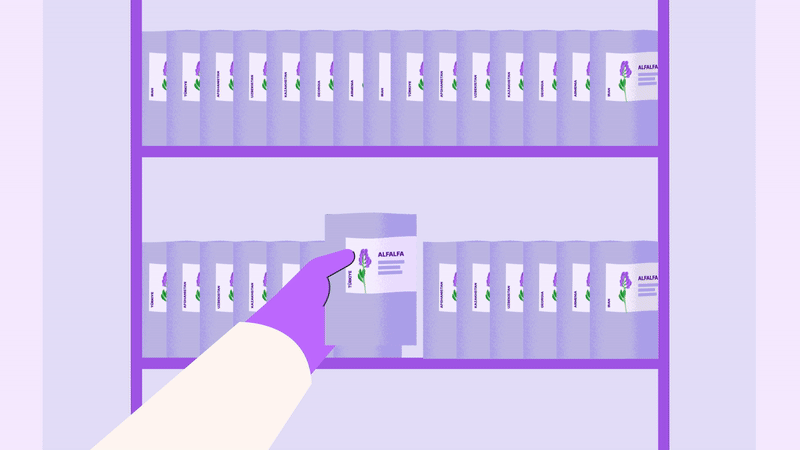
For farmers, this would have been a disaster. For the breeders, it was a delight, living proof that at least a few of their new varieties could cope with extremely low temperatures. Those varieties are now boosting the profits of smallholder dairy farmers in Kazakhstan, who supply three-quarters of the country’s milk, by providing better nutrition for their cows, as well as honey from the bees brought in to pollinate the crop and supply the seed industry.
In places like Chile, the challenge is not freezing winters but long, hot and dry summers. Large growers can invest in irrigation; smallholder farmers now have access to new varieties reinforced with genes from wild relatives that allow them to make do with a lot less water.
In a way, this is nothing new. The second great expansion of alfalfa, to the new world in the 18th century, also needed varieties that could cope with harsh conditions, a need fulfilled by natural hybrids collected throughout Russia and Central Asia.
While modern plant breeding, based on fresh crosses with wild relatives, is providing smallholder farmers around the world with varieties that meet their needs, there is a different, perhaps more contentious, approach. It can sometimes make sense to invest in growing alfalfa under conditions you might think would be very inhospitable. Fly over the Kalahari desert in southern Africa, for example, and you will see bright green circles on its dry plains: alfalfa, irrigated by huge rotating sprinklers that draw water from deep underground. That pattern is repeated in many places, including the southwestern USA, where I’m allowed to guzzle more than a third of the water that agriculture removes from the Colorado River.
That makes economic sense because I produce such valuable fodder. Given a good supply of water, endless warmth and sunshine allows farmers to harvest fresh alfalfa hay practically every month, which is even more profitable when the water is “free”. In Arizona, for example, Saudi Arabia and Abu Dhabi commercial farmers use land to grow alfalfa hay which they then ship to the Middle East for dairy cattle there. I’m conflicted about that. It is good news for alfalfa, I admit. But it means there is less water in underground aquifers where it could be used more directly by people. Opponents of these schemes say that the amount of water exported each year as hay would be enough to supply a million humans.
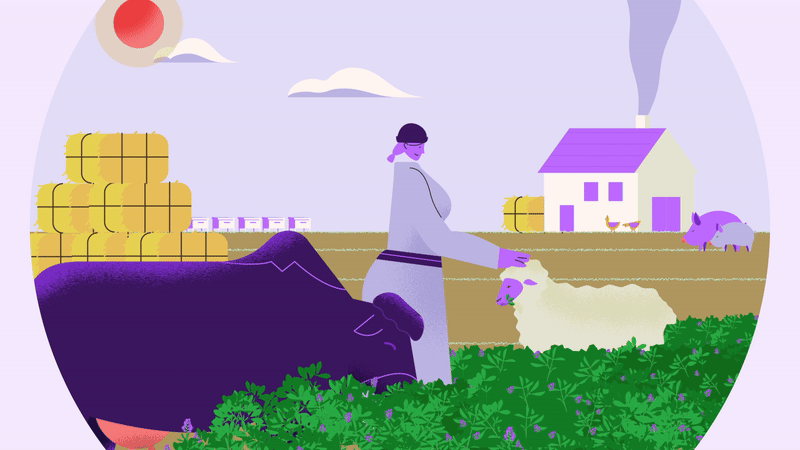
No wonder, then, that from my centre of origin in the area now known as Azerbaijan and Kazakhstan I have gone forth to become the world’s most widely cultivated forage plant. That journey influenced the names people gave me. The Greeks, after Marathon, called me mhdich, for Media where I came from. For Arabs, I was al-fasfasa, meaning “fresh fodder” or, possibly, “horse power”. The Spaniards turned that into alfalfa, and because it was Spaniards who first took me to the Americas, that is the name that took root there. So what about lucerne? Some say that is because the first European introductions took place around Lake Lucerne in Switzerland. I prefer to think it comes from the ancient Persian word läjwärd, for blue lapis lazuli from Afghanistan, because my gorgeous blue flowers reminded people of that precious mineral.
Did You Know?
-
Scientific names: Medicago sativa
-
Origin: Central Asia ~9,000 years BP
-
Used and grown around the world: In 2021 FAO estimated alfalfa exports of 1,543,423 tonnes worth USD 500,992,000. Imports totalled 36,621 tonnes, worth USD 15,044,000. Most alfalfa is grown for domestic consumption. The United States and Spain are the main exporters while China, United Arab Emirates and Saudi Arabia are the main importers. Global trade in 2023 is estimated at USD 24,140,000,000.
-
A fun fact: The coiled seed pods of alfalfa might have evolved to deter a beetle pest. In Victorian England, they were sometimes pickled and added to salads as “snails”.
-
Conservation status: About 21,175 accessions are conserved worldwide, according to Genesys: including 4,103 in the USDA Western Regional Plant Introduction Station in Washington, United States, 3,664 in the N.I. Vavilov Research Institute of Plant Industry in Russia, and 3,041 in the Australian Pastures Genebank. The main collections have been collected by the USA (2,879), Russia (1,659) and Italy (1,246). About 3,600 accessions are safety duplicated in the USDA National Seed Storage Laboratory in Nebraska, USA, 1,990 in the Svalbard Global Seed Vault, and 402 in the Australian Winter Cereals Collection.
This story is part of Crop Chronicles, a multimedia campaign that uncovers the stories of the crops that feed the world, the people who grow them and the race to adapt them to a changing climate.

